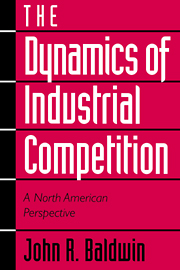Book contents
- Frontmatter
- Contents
- preface
- Acknowledgements
- 1 The dynamics of competition
- 2 Greenfield entry and closedown exit
- 3 Entry, exit, and the merger process
- 4 The rise and fall of incumbents
- 5 Patterns of large- and small-firm mobility
- 6 Plant turnover in Canada and the United States
- 7 Measures of market structure and the intensity of competition
- 8 The relationship between mobility and concentration
- 9 Turnover and productivity growth
- 10 Merger success
- 11 Turnover in domestic and foreign enterprises
- 12 Industry efficiency and firm turnover in the Canadian manufacturing sector
- 13 Firm turnover and profitability
- 14 Modelling entry
- 15 Conclusion
- Appendix A Measuring firm turnover – methodology
- Appendix B Definition of concentration and mobility measures
- Notes
- References
- Author index
- Subject index
12 - Industry efficiency and firm turnover in the Canadian manufacturing sector
Published online by Cambridge University Press: 30 March 2010
- Frontmatter
- Contents
- preface
- Acknowledgements
- 1 The dynamics of competition
- 2 Greenfield entry and closedown exit
- 3 Entry, exit, and the merger process
- 4 The rise and fall of incumbents
- 5 Patterns of large- and small-firm mobility
- 6 Plant turnover in Canada and the United States
- 7 Measures of market structure and the intensity of competition
- 8 The relationship between mobility and concentration
- 9 Turnover and productivity growth
- 10 Merger success
- 11 Turnover in domestic and foreign enterprises
- 12 Industry efficiency and firm turnover in the Canadian manufacturing sector
- 13 Firm turnover and profitability
- 14 Modelling entry
- 15 Conclusion
- Appendix A Measuring firm turnover – methodology
- Appendix B Definition of concentration and mobility measures
- Notes
- References
- Author index
- Subject index
Summary
The instruments of labour are largely modified all the time by the progress of industry. Hence they are not replaced in their original, but in their modified form. On the one hand the mass of the fixed capital invested in a certain bodily form and endowed in that form with a certain average life constitutes one reason for the only gradual pace of the introduction of new machinery etc., and therefore an obstacle to the rapid general introduction of improved instruments of labour. On the other hand, competition compels the replacement of the old instruments of labour by new ones before the expiration of their natural life, especially when decisive changes occur.
Karl Marx (1966: vol. 1, 381)Introduction
While both Marx and Marshall recognized the diversity of production techniques that were likely to be employed at any given time, recent studies of industry performance generally fail to recognize the diversity of firms within an industry. For example, productivity growth is generally measured at the industry level with almost complete disregard for the underlying production entities, probably because of the widely accepted concept of a representative or average firm. As Reid (1987) points out, in industrial organization the Vinerian concept of the representative firm has been dominant at the expense of the more complex notion of the diversity of firm performance stressed by Marshall. As a result, the mainstream of industrial organization has had trouble in coming to grips with the reality of heterogeneity of firm performance within industries.
One of the few areas of applied industrial economics that acknowledges firm heterogeneity is the literature on X-inefficiency.
- Type
- Chapter
- Information
- The Dynamics of Industrial CompetitionA North American Perspective, pp. 298 - 327Publisher: Cambridge University PressPrint publication year: 1995
- 3
- Cited by



